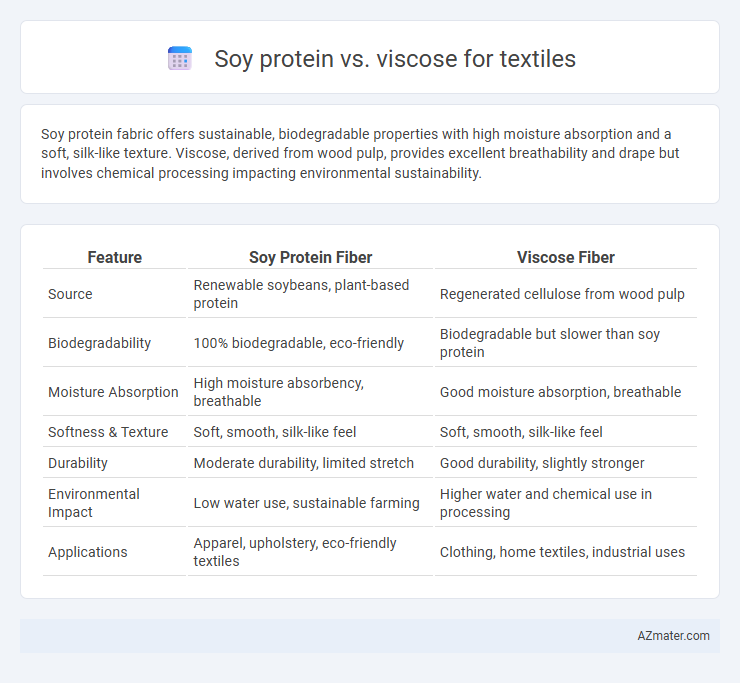Soy protein fabric offers sustainable, biodegradable properties with high moisture absorption and a soft, silk-like texture. Viscose, derived from wood pulp, provides excellent breathability and drape but involves chemical processing impacting environmental sustainability.
Table of Comparison
| Feature | Soy Protein Fiber | Viscose Fiber |
|---|---|---|
| Source | Renewable soybeans, plant-based protein | Regenerated cellulose from wood pulp |
| Biodegradability | 100% biodegradable, eco-friendly | Biodegradable but slower than soy protein |
| Moisture Absorption | High moisture absorbency, breathable | Good moisture absorption, breathable |
| Softness & Texture | Soft, smooth, silk-like feel | Soft, smooth, silk-like feel |
| Durability | Moderate durability, limited stretch | Good durability, slightly stronger |
| Environmental Impact | Low water use, sustainable farming | Higher water and chemical use in processing |
| Applications | Apparel, upholstery, eco-friendly textiles | Clothing, home textiles, industrial uses |
Introduction to Soy Protein and Viscose Fibers
Soy protein fibers are derived from soybean meal, offering a sustainable and biodegradable alternative in textiles with natural moisture-wicking and softness. Viscose fibers, made from chemically processed cellulose derived from wood pulp, provide high breathability and silk-like texture, widely used in fashion and home textiles. Both fibers present eco-friendly options, balancing performance with environmental considerations in fabric production.
Origins and Production Processes
Soy protein fibers originate from soybean residue, primarily derived by extracting protein from soybeans and then spinning it into fibers through a regenerative process. Viscose is produced from cellulose extracted from wood pulp, which is chemically treated with sodium hydroxide and carbon disulfide to create a viscous solution that is then spun into fibers. Both fibers involve sustainable raw material sources, but soy protein relies on agricultural by-products, while viscose depends on forestry resources and intensive chemical processing.
Environmental Impact Comparison
Soy protein fibers exhibit a significantly lower environmental footprint compared to viscose, as soy protein production utilizes renewable agricultural by-products and requires less water and energy during processing. Viscose manufacturing involves high chemical usage and deforestation concerns due to reliance on wood pulp, leading to greater pollution and habitat loss. Choosing soy protein fibers can reduce carbon emissions and promote sustainable resource management in the textile industry.
Physical Properties and Performance
Soy protein fibers offer excellent moisture absorption and biodegradability, contributing to comfortable and eco-friendly textiles. Viscose boasts high tensile strength, smooth texture, and good drape, making it ideal for soft and flowing garments. While soy protein fibers provide moderate durability and warmth retention, viscose excels in breathability and color retention during laundering.
Comfort and Wearability
Soy protein fibers offer superior moisture absorption and natural breathability compared to viscose, enhancing overall comfort in textile applications. The elasticity and softness of soy protein fabrics result in better wearability with less skin irritation and improved durability. Viscose, while smooth and lightweight, tends to retain moisture longer, which can reduce comfort during prolonged wear.
Dyeability and Color Retention
Soy protein fibers exhibit excellent dyeability due to their natural amino acid structure, allowing them to absorb a wide range of dyes evenly with vibrant colors. Viscose, being a regenerated cellulose fiber, also offers good dye uptake but often requires higher dyeing temperatures and chemicals to achieve similar color intensity. In terms of color retention, soy protein fibers tend to maintain hue longer under sunlight and washing conditions, whereas viscose fabrics may experience quicker fading due to their hydrophilic nature and weaker fiber stability.
Biodegradability and End-of-Life Options
Soy protein fibers exhibit high biodegradability, breaking down naturally within months under composting conditions, making them an eco-friendly choice for sustainable textiles. Viscose, derived from regenerated cellulose, is biodegradable but requires specific conditions such as industrial composting to effectively decompose, often taking longer than soy protein. End-of-life options for soy protein textiles prioritize composting and biodegradation in natural environments, whereas viscose can be recycled through chemical regeneration or disposed of in industrial compost facilities, highlighting the importance of proper waste management for minimizing environmental impact.
Cost and Market Availability
Soy protein fibers tend to be more expensive than viscose due to higher raw material processing costs and limited production scale. Viscose is widely available in the market, benefiting from established manufacturing infrastructure and abundant cellulose sources, resulting in lower prices. The broader adoption of viscose in textiles contrasts with the niche positioning of soy protein fiber, which remains less accessible globally.
Applications in Textile Industry
Soy protein fibers offer sustainable and biodegradable options ideal for eco-friendly textile applications such as apparel, upholstery, and non-woven fabrics, providing softness and moisture absorption similar to natural fibers. Viscose, derived from regenerated cellulose, is widely used in fashion, home textiles, and industrial fabrics due to its silk-like appearance, breathability, and dye affinity, making it a versatile choice for high-quality garments and interiors. Both materials contribute to diverse textile solutions, with soy protein emphasizing sustainability and viscose balancing affordability with comfort and aesthetic appeal.
Future Trends and Innovations
Soy protein fibers offer sustainable alternatives to viscose, leveraging renewable plant-based sources that reduce environmental impact and water consumption. Innovations in bioengineering and fiber processing are enhancing soy protein's durability and softness, positioning it as a viable competitor to viscose in eco-friendly textile production. Future trends indicate growing demand for biodegradable, low-impact fibers, driving research into soy protein composites and circular textile manufacturing methods.

Infographic: Soy protein vs Viscose for Textile
 azmater.com
azmater.com